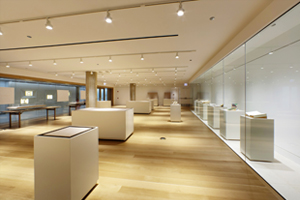Center of attention
A renovation gives Special Collections a place to exhibit its full potential.
By Elizabeth Brandon
Photography by Jason Smith

Display quality: the new Special Collections gallery provides a modern space for exhibits.
Before its recent renovation, the Special Collections Research Center’s exhibit space consisted of 24 cases lining the walls of a hallway leading to restrooms. Only half of the cases and three table-top displays were even inside the center.
The gallery had remained unchanged since 1970, when Special Collections opened alongside the Regenstein Library. “Over time we began to realize that the design of the gallery was limiting the type of exhibitions we could do and range of materials we were able to display,” says Daniel Meyer, AM’75, PhD’94, Special Collections associate director and University archivist.
In 2006 a provost-appointed task force studying the libraries called for more space not only in the gallery but also for research and study areas. Meanwhile the construction of the Joe and Rika Mansueto Library, set to open officially this fall, required Special Collections to create a walkway between Mansueto and the Reg. An immediate need to rebuild, coupled with the desire for more space, provided an opportunity to rethink the center’s layout.
Work on the design by Booth Hansen began in winter 2009. In addition to improved exhibit space, the center has upgraded its large conference room—which can now accommodate up to 100 people in auditorium-style seating—with built-in media and better acoustics.
The renovation also added a second group-study room, allowing more people to work with materials in Special Collections. “Our open-access philosophy in Special Collections actually predates the renovation,” says Judith Nadler, director of the University libraries, but the construction has permitted the center to better put the policy into practice.
A smart classroom and continuing efforts to digitize text in Special Collections and other campus libraries exemplify the library’s forward-looking direction, says Nadler. And Special Collections connecting the Regenstein with the new Mansueto facility is appropriate, she says: “Special Collections brings together the older materials, unique materials, and rare materials, and in this new context with technology that is pointing to the future.”
The first exhibit in the new gallery, Firmness, Commodity, and Delight: Architecture in Special Collections, runs May 9 through July 29. Curated by Meyer, the show highlights blueprints, books, graphic materials, and other items in Special Collections that explore architectural history.
In contrast to the hallway outside the center where parts of previous shows were displayed, the 2,384-square-foot gallery functions solely as an exhibit space. Special Collections director Alice Schreyer notes the “subtlety” of the overall renovation in relation to the gallery: “They built a dramatic new space; they renovated and improved existing spaces, making them all work together, not looking like they were all patched together.”
In August the first faculty- and student-led show opens in the gallery. Adventures of the Soviet Imaginary: Soviet Children’s Books and Posters runs through the end of December. Robert Bird, associate professor in the department of Slavic languages and literature, is coordinating the exhibit. The new space, he says, “really showcases the exhibition in a way that I don’t think has been possible before.” In addition to adjustable lighting, the gallery incorporates a larger diversity of cases—11 of varying sizes and a 36-foot-long case running the length of the back wall.
Special Collections, which reopened March 28, celebrates its renovation May 18 with a reception and an open house.
Return to top
